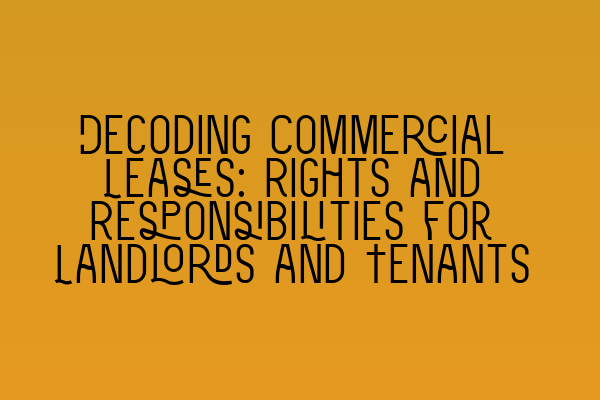Decoding Commercial Leases: Rights and Responsibilities for Landlords and Tenants
Commercial leases are an essential component of the real estate industry. Whether you are a landlord or a tenant, understanding the rights and responsibilities associated with commercial leases is crucial to ensuring a smooth and successful business relationship. In this article, we will decode the intricacies of commercial leases, shedding light on the important aspects that both landlords and tenants should know.
1. Understanding Commercial Lease Agreements
A commercial lease agreement is a legally binding contract that outlines the terms and conditions under which a property is rented out for commercial use. These agreements typically cover a wide range of aspects, including rent, lease duration, maintenance responsibilities, and more.
For landlords, it is essential to draft a comprehensive commercial lease agreement that protects your interests. This includes clearly defining the rental amount, payment schedule, allowable uses of the property, and any restrictions on alterations and subletting. By taking these factors into account, you can minimize potential disputes and protect your investment.
Tenants, on the other hand, should thoroughly review the commercial lease agreement to ensure that it aligns with their business needs. Understanding the terms related to rent increases, renewal options, maintenance responsibilities, and any restrictions or exclusions is crucial to avoid any surprises down the line.
2. Rent and Rent Review
Rent is a fundamental aspect of any commercial lease agreement. As a landlord, it is essential to set the rent at a fair and competitive market rate. Conducting market research and consulting with professionals can help you determine the appropriate rent for your property.
In many commercial lease agreements, there may be a provision for rent review. Rent reviews typically occur at predetermined intervals, allowing landlords to adjust the rental amount to reflect changes in market conditions. Tenants should be aware of the rent review clause and understand their rights and obligations when it comes to potential rent increases.
Learn more about rent and rent reviews in our SQE 1 Practice Exam Questions article.
3. Maintenance and Repairs
Responsibilities for maintenance and repairs are typically outlined in the commercial lease agreement. As a landlord, you have the obligation to maintain the property’s structural integrity and ensure that it is suitable for the tenant’s chosen use.
Tenants, on the other hand, are generally responsible for day-to-day maintenance and minor repairs. However, the specific details regarding maintenance and repairs should be clearly stated in the lease agreement. Understanding these obligations is critical for both landlords and tenants to avoid any confusion or disputes in the future.
For more information on how maintenance and repairs are addressed in commercial leases, visit our SQE 1 Practice Mocks FLK1 FLK2 article.
4. Alterations and Improvements
Commercial tenants often have a need to make alterations or improvements to the leased property to better suit their business requirements. However, before making any changes, tenants must obtain the landlord’s consent. Landlords have the right to impose certain conditions and restrictions regarding alterations to ensure that the property’s value and functionality are maintained.
Tenants should carefully review the lease agreement to understand the process for obtaining consent for alterations and improvements. This may involve submitting detailed plans, securing the necessary permits, and potentially restoring the premises to its original condition upon the termination of the lease.
Our SQE 2 Preparation Courses article offers additional insights into the complexities of alterations and improvements in commercial leases.
5. Termination and Renewal
Commercial leases have a specific duration, which is typically determined at the start of the lease agreement. Both landlords and tenants should understand the termination and renewal provisions outlined in the lease.
For landlords, it is important to be aware of the notice period required for termination and the options available for renewing the lease. Planning ahead and ensuring open communication with tenants can help mitigate potential issues during lease termination or renewal.
Tenants, on the other hand, should plan for lease termination well in advance to allow sufficient time for relocation or negotiating a new lease. Understanding the notice period and renewal options can help tenants make informed decisions about their business’s future.
For more information on lease termination and renewal, consult our comprehensive SQE 1 Preparation Courses article.
Conclusion
Decoding commercial leases can be a complex task, but understanding the rights and responsibilities of landlords and tenants is essential for maintaining a successful business relationship. By thoroughly reviewing and comprehending the terms and conditions laid out in the commercial lease agreement, both parties can ensure a smooth and mutually beneficial leasing experience.
For additional resources and information on property law and land law, consider browsing our website. Stay updated on the latest SRA SQE exam dates and prepare yourself with our educational resources to excel in your legal career.
References:
